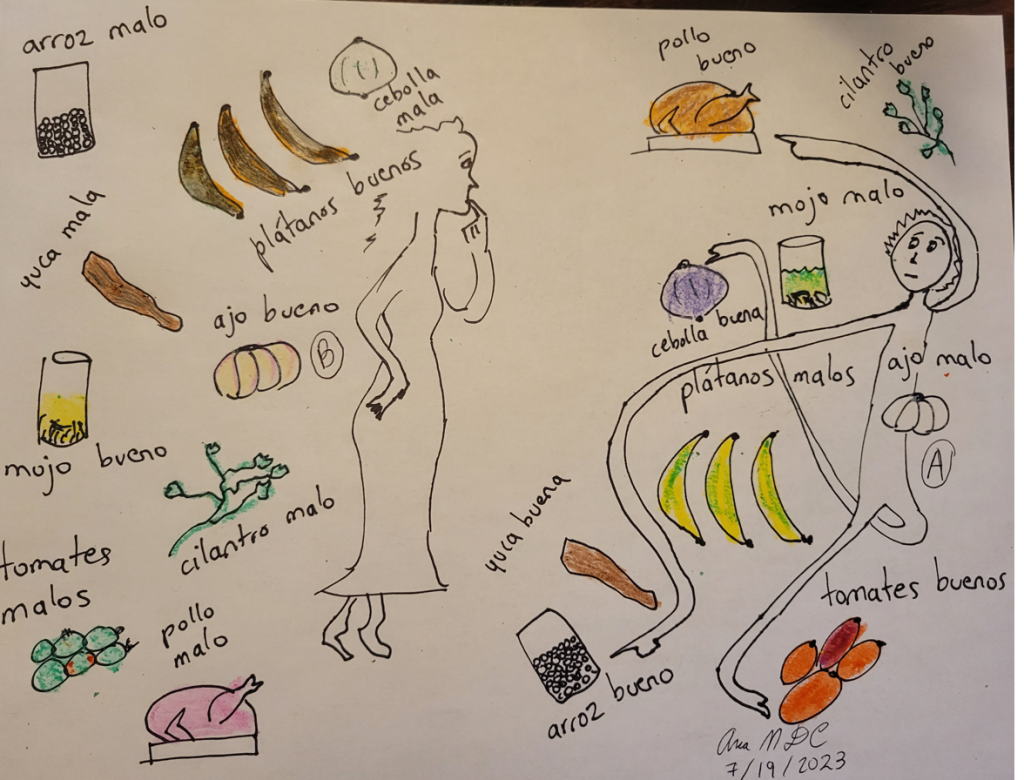58 Demonstratives: that, this, those, these
Demonstratives are words that serve to point to an object, and state whether it’s far or close to you. When an object is close to you, you say “this” when the object is only one or “these” if you are referring to several of them. When an object is far from you, you say “that” when the object is only and “those” when there are several. In Spanish is the same, just that you also need to mark whether the word for the object is feminine or masculine.
Cerca=closeby
| Masculine | Feminine | |
| Singular | este (=this) | esta (=this) |
| Plural | estos (=these) | estas (=these) |
Lejos=far
| Masculine | Feminine | |
| Singular | ese (=that) | esa (=that) |
| Plural | esos (=those) | esas (=those) |
Notice that when the object is close, you only have to add a T.
Demonstratives aquello/aquella/aquellos/aquellas are synonyms to demonstratives to ese/esa/esosesas in common Spanish. However, some people may use aquello/aquella/aquellos/aquellas when something is slightest farther away.
Demonstratives go before the object in sentences, as in the following examples:
- Este teléfono suena y suena (=This phone sounds and sounds, and it’s close to me)
- Yo no oigo ese teléfono (=I don’t hear that phone because it’s far)
- Estos zapatos son muy incómodos (=These shoes are very uncomfortable, and I have them on)
- Esos zapatos están dañados (=Those shoes are damaged, and are in a different place)
- Esta niña es mi hija (=This girl is my daughter, and she’s next to me)
- Esa niña es mi hija (=That girl is my daughter, and it’s over there)
- Estas gafas no me sirven (=These glasses don’t work, and I’m wearing them)
- Esas gafas están perdidas (=Those glasses are lost, and are far)
When you are referring to an object that YOU DON’T KNOW THE GENDER OR NUMBER, prefer ESTO or ESO, and that’s why ESTO or ESO are commonly used in questions. The answer to the question may still start with ESTO or ESO:
A: ¿Qué es esto?
B: Esto es un plátano. OR Esto es una naranja. OR Esto son sandías (=watermelons).
A: ¿Qué es eso?
B: Eso es un cuervo (=crow). OR Eso es una paloma (=pigeon). OR Eso son águilas (=eagles).
There are words that signal closeness and farness:
- aquí=right here
- ahí=(around) there
- allí=right there
- allá=over there
Sample conversation:
Here and there
A: ¿Qué hay aquí?
B: Aquí están _______________, _______________ y _______________ (add demonstrative + object with objects close to you, and point them as you speak).
A: ¿Qué hay allá?
B: Allá están _______________, _______________ y _______________ (add demonstrative + object with objects far from you, and point them as you speak).
Objects close to you: gafas (=glasses), computador (=computer), teléfono (=telephone), lapicero (=pen), cuaderno (=notebook), papel (=paper)
Objects far from you: casa (=house), edificio (=building), tablero (=blackboard), ventana (=window), montaña (=mountain)
Picking food at a supermarket
A and B are discussing what produce items are good or bad. B likes produce items labeled as “bueno”, while he dislikes those labeled as “malo”.
A: ¿Cuál ___________ (add produce item) te gusta?
B: Me gusta ___________ (add demonstrative) ___________ (add produce item).

Buying goods
Pretend you are holding a conversation in Miami in a farmer’s marker from all Cubans, and you need to speak Spanish. All levels are going to make up a conversation between A and B where A is the buyer and B is the seller. Perform the conversation FIVE TIMES by adding items below with their respective prizes.
A: ¿Qué vendes?
B: Vendo ____________.
A: ¿Cuánto vale (=costs)?
B: Vale _________ dólares. / Valen ___________ dólares. (Add an “n” if referring to more than one thing.).
Repeat as many times including the following goods:
- Plátanos: 5 dólares por libra
- Güiro: 12 dólares
- Mojo: 3 dólares por frasco
- Yuca: 3 dólares por libra
- Lechón: 500 dólares completo, 5 dólares por porción
- Botella de ron: 50 dólares la botella, 5 dólares el shot
At the end of the conversation, decide which items you want to buy, and the Cuban seller will tell you the total. The total has to be the real total that shows your own counts.
A: Quiero comprar ____________________, ______________________ y ________________________.
B: Muy bien, son _________________________ (the Cuban adds the total).
If you are an Intermediate, Advanced, or Native speaker of Spanish, you’re going to do regateo (bargaining). That means, you’re going the bargain the total price of the items, and come to a resolution. Say good bye.
